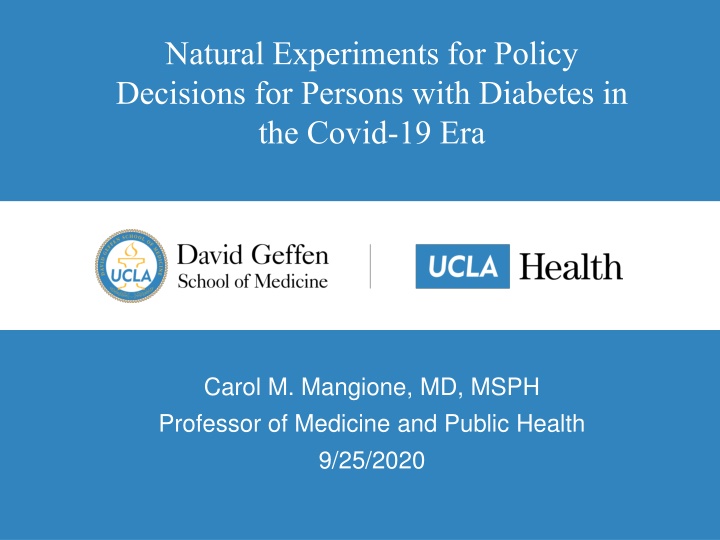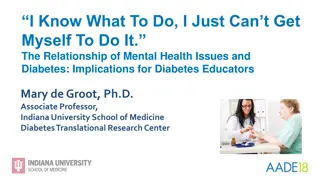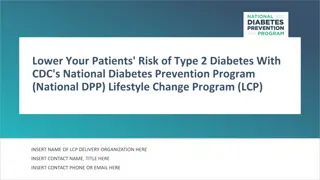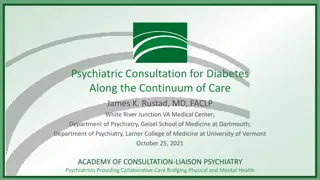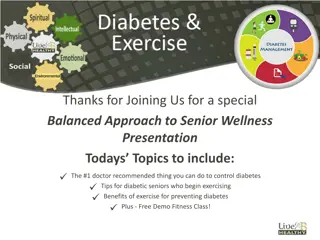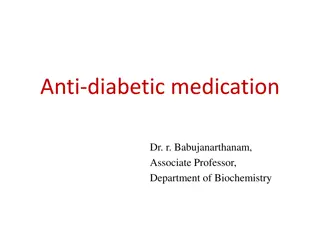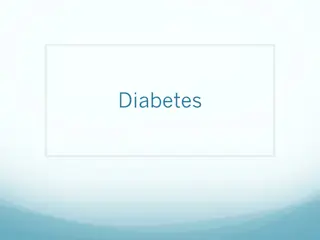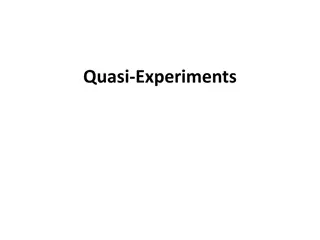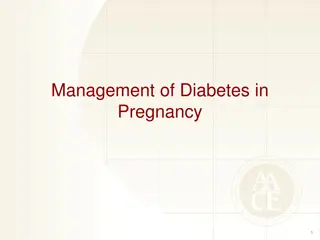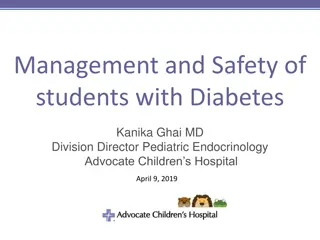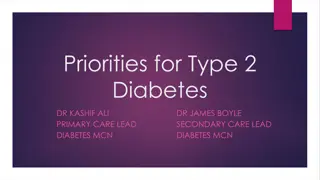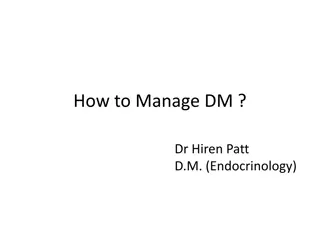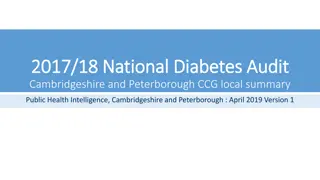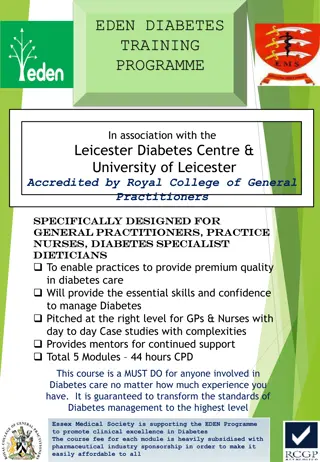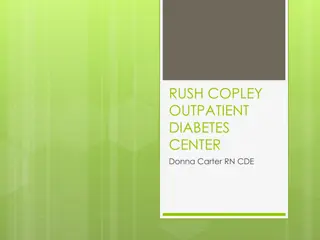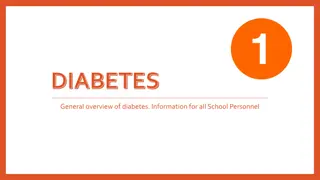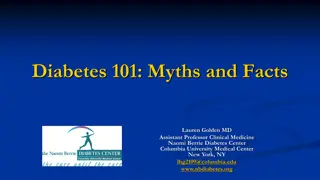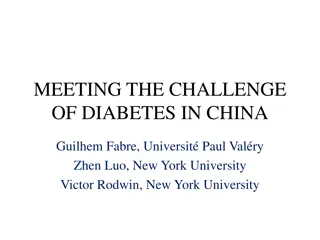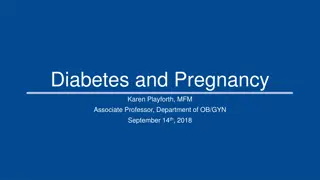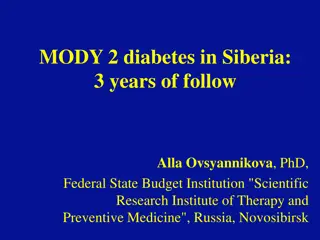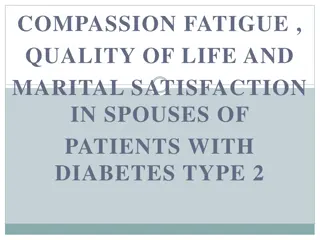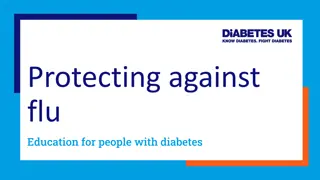Natural Experiments for Policy Decisions for Persons with Diabetes in the Covid-19 Era
This presentation by Dr. Carol M. Mangione explores unintended natural experiments resulting from the pandemic's impact on outpatient care, telehealth adoption, and the disproportionate burden on individuals with diabetes. It delves into the clinical and economic consequences of Covid-19, emphasizing the need for research to inform effective policies and healthcare delivery for those with diabetes.
Download Presentation

Please find below an Image/Link to download the presentation.
The content on the website is provided AS IS for your information and personal use only. It may not be sold, licensed, or shared on other websites without obtaining consent from the author.If you encounter any issues during the download, it is possible that the publisher has removed the file from their server.
You are allowed to download the files provided on this website for personal or commercial use, subject to the condition that they are used lawfully. All files are the property of their respective owners.
The content on the website is provided AS IS for your information and personal use only. It may not be sold, licensed, or shared on other websites without obtaining consent from the author.
E N D
Presentation Transcript
Natural Experiments for Policy Decisions for Persons with Diabetes in the Covid-19 Era Carol M. Mangione, MD, MSPH Professor of Medicine and Public Health 9/25/2020
Outline Unintended natural experiments from the pandemic: Abrupt disruption of outpatient care Rapid Transition to Telehealth: Rethinking DM care delivery Disproportionate burden of Covid-19 on persons with Diabetes and Black and LatinX persons Immediate and longer term clinical consequences of Covid- 19 for persons with diabetes Economic consequences of Covid-19: Loss of employment/Loss of health insurance Mental and physical health consequences Natural experiments are needed to study these pandemic related shocks and ultimately inform both policies and clinical care delivery to mitigate harm for persons with diabetes.
The Pandemic Influences Complex Drivers of Supply and Demand SUPPLY* DEMAND Systems Clinicians Individuals & Families Clinical Profile (age, co-morbidities) Self-care opportunities(diet, physical activity, medication adherence) Psychological vulnerability vs. resilience (fear, isolation, depression, anxiety) Access to and capabilities with technology Competing priorities (teleworking, homeschooling) Psychological vulnerability vs. resilience (fear, sense of duty) Access to and capabilities with technology Policies regarding new and non-urgent visits Employment changes (layoffs, furloughs, redeployment) Concerns for employee safety (PPE shortages) Ambulatory Visits Concerns for patient safety (workflows) Telehealth Visits Economic circumstances (revenue loss) Medico-legal concerns Employment(layoffs) and loss of health insurance PUBLIC HEALTH INFLUENCES: State- and Federal mandates and recommendations From: M. Ali and C. Mangione. Health Affairs, In Press, 2020
Covid-19 and the Rise of Virtual Care Wosik J, et al. Telehealth transformation: COVID-19 and the rise of virtual care. J Am Med Inform Assoc. 2020;27(6):957-962. doi:10.1093/jamia/ocaa067
The Rise of Telehealth at UCLA - Unpublished Data Do Not Cite Office of Health Informatics and Analytics, UCLA Health Information Technology
UCLA Telehealth by Age Unpublished Data Do Not Cite Office of Health Informatics and Analytics, UCLA Health Information Technology
UCLA Health Unpublished Data Do Not Cite Patient Satisfaction Survey Results for Video Visits After every video visit, a patient is sent survey asking about their experience. In August 2020 we had 2,926 responses from >55K visits. Given the option, I would choose to have a Video Visit again in the future: Overall, I was satisfied with my Video Visit Session: Status Report
A Natural Experiment What does the abrupt disruption in outpatient care and rise of virtual care mean for prevention of diabetes & deliver of diabetes processes of care? A1c checks Fasting lipids Microalbuminuria checks Foot exams Flu shots/Pneumococcal Vaccination Dilated Eye Exams Blood pressure monitoring Consideration of ASA BMI/Lifestyle counseling Medication management & adherence Lab Visit In Person Telehealth
Disproportionate Burden of Covid-19 for Persons with Cardiometabolic Diseases and for Blacks and LatinX 10
One of the earliest case series from NYC reported a higher prevalence of men, Blacks, LatinX, and persons with Obesity or Diabetes among 5,700 hospitalized persons. Richardson S, et al. Presenting Characteristics, Comorbidities, and Outcomes Among 5700 Patients Hospitalized With COVID-19 in the New York City Area. JAMA. 2020;323(20):2052 2059. doi:10.1001/jama.2020.6775
Summary measures and univariable association of sociodemographic characteristics with SARS-CoV-2 infection from HM CURATOR Overall SARS-CoV-2- negative Characteristics (N=20228) (n=18 677) Age, mean (SD) 51.1(19.0) 51.0(19.1) SARS-CoV-2- positive (n=1551) 52.1(18.1) OR (95%CI)* 1.00 (1.00 to 1.01) Race (%) White 62.3 62.9 55.7 Reference category 1.55 (1.37 to 1.75) 1.20 (1.00 to 1.44) 1.36 (0.88 to 2.11) 2.02 (1.79 to 2.27) Black Asian Mixed/other Hispanic (%) CCI categories (%) Hypertension Diabetes (without 21.6 9.2 1.3 17.8 21 9.1 1.2 16.8 28.8 9.7 1.5 29.2 ) 47.2 24.2 47.1 23.7 48.4 30.3 1.06 (0.95 to 1.17) 1.40 (1.24 to 1.57) complications) Obesity 28 28.2 25.2 0.86 (0.76 to 0.96) Vahidy FS, et al. BMJ Open 2020;10:e039849. doi:10.1136/ bmjopen-2020-039849
Increased Odds of SARS-CoV-2 Positivity by Race/Ethnicity Vahidy FS, et al. BMJ Open 2020;10:e039849. doi:10.1136/ bmjopen-2020-039849
COVID-NET Data from 14 States Garg S, et al. Hospitalization Rates and Characteristics of Patients Hospitalized with Laboratory-Confirmed Coronavirus Disease 2019 - COVID-NET, 14 States, March 1-30, 2020. MMWR Morb Mortal Wkly Rep. 2020;69(15):458-464. Published 2020 Apr 17. doi:10.15585/mmwr.mm6915e3
Blacks who test positive for SARS-Cov-2 are more likely to have cardiometabolic diseases Table 1. Characteristics of 3481 Patients Who Tested Positive for Coronavirus Disease 2019 (Covid-19) by April 11, 2020.* White Non-Hispanic (N = 1030) Black Non-Hispanic (N = 2451) Characteristic Age yr 55.5 18.5 53.6 16.1 Sex no. (%) Male 471 (45.7) 923 (37.7) Female 559 (54.3) 1528 (62.3) Coexisting conditions Obesity no. (%) 407 (39.5) 1320 (53.9) Diabetes no. (%) 112 (10.9) 454 (18.5) Hypertension no. (%) 246 (23.9) 828 (33.8) * Plus minus values are means SD. Race and ethnic group were reported by the patient. Percentages may not total 100 because of rounding. COPD denotes chronic obstructive pulmonary disease, and HIV the human immunodeficiency virus. Absence of diagnoses recorded in the medical record was assumed to mean absence of the conditions. Obesity was determined by the presence of diagnosis codes or a body-mass index (BMI) of 30 or more that was recorded during previous clinical encounters (1727 patients had a BMI of 30; 1071 had a BMI of <30; and 683 had missing data). Price-Haywood EG et al. N Engl J Med 2020;382:2534-2543
Blacks are more likely to require intensive care with Covid-19 From Table 2. White Non- Hispanic (N = 319) Black Non-Hispanic Characteristic Level of hospital care no. (%) Critical care: intensive care units Ventilator No ventilator Noncritical care: medicine surgical units Clinical outcome no. (%) Still admitted Discharged alive from hospital Died Median length of hospital stay (IQR) days (N = 1063) 94 (29.5) 67 (21.0) 27 (8.5) 225 (70.5) 380 (35.7) 297 (27.9) 83 (7.8) 683 (64.3) 13 (4.1) 210 (65.8) 96 (30.1) 7.0 (3.0 13.0) 49 (4.6) 784 (73.8) 230 (21.6) 6.0 (3.0 12.0) Shown is the highest level of hospital care received at any time during the hospital course. Only deceased or discharged patients were used for calculations of length of hospital stay. Price-Haywood EG et al. N Engl J Med 2020;382:2534-2543
Natural Experiment: Given the increased probability of Covid-19 infection, hospitalization, and disease severity, does infection with Covid-19 change the long term clinical trajectory for persons with Diabetes? 17
The ACA is a Buffer after job loss for retaining health insurance BeforeACA (2011 2013) AfterACA (2014 2016) 80 Medicaid 70 Medicare or other InsuranceCoverage(%) 60 Private, non-ESI (includes marketplace) 50 Private, ESI 40 30 20 10 0 BeforeJobLoss AfterJobLoss BeforeJobLoss AfterJobLoss Difference-in-Differences percentage points (95% CI) 6.0 (0.9 to 11.1) 0.5 ( 4.0 to 5.0) 0.3 ( 2.6 to 3.2) 2.6 (1.0 to 4.1) 3.7 (0.1 to 7.3) 1.4 (0.0 to 2.9) 6.0 ( 11.1to 0.9) 66.3 49.7 5.8 8.6 2.2 33.7 61.7 36.9 8.0 13.8 3.1 38.3 76.2 50.3 9.4 2.2 14.6 1.9 23.8 77.6 37.9 11.9 4.8 23.5 4.2 22.4 AnyCoverage (%) Private,ESI (%) Private,Non-ESI (%) Marketplace(%) Medicaid (%) MedicareorOther (%) Uninsured (%) Pre- and Post-ACA Health Insurance Coverage among Nonelderly Adults with Job Loss. Bold type indicates a differences-in-differences estimate that is significant at P<0.05 (see the Supplementary Appendix for details). Data are from the Medical Expenditure Panel Survey for 2011 2016. The sample included all adults 19 to 64 years of age who had any employment in the first round of the survey but had becomeunemployedbythe final round (pre-ACA,N=1350;post-ACA, N=1103).Participantswere interviewed in five roundsover 2years. Themean ageof the full population-weightedcohort was 39.7years,and57.5%of participantswere female,13.5%were Black, and17.7%were Hispanic. Insurancetypes were mutuallyexclusiveandwere defined accordingto thefollowinghierarchy:(1) employer-sponsoredinsurance(ESI),(2) Medicaid,(3) mar-ketplaceor nongroupinsurance,(4) Medicareor other, and(5) uninsured. Percentages maynot total 100becauseof rounding. CI denotesconfidenceinterval. Agarwal SD, Sommers BD. Insurance Coverage after Job Loss - The Importance of the ACA during the Covid-Associated Recession [published online ahead of print, 2020 Aug 19]. N Engl J Med. 2020;10.1056/NEJMp2023312. doi:10.1056/NEJMp2023312
But what has happened in the pandemic? TABLE2Changes in Insurance Status, Food Insecurity, and Food Assistance Programs, Before and After March 2020 P Insurance statusa Before March 2020, % (95% CI) Since March, 2020, % (95% CI) ,.001 Employer-sponsored insurance Medicaid or CHIP Private insurance Exchange plan TriCare Uninsured Other Food insecuritya None Mild Moderate Severe Food assistance programsb Food stamps or SNAP WIC Food banks Free or reduced-price school lunch P- EBTc Free food from school None 62.7 (59.4 to 66.1) 22.7 (19.7 to 25.7) 3.3 (2.1 to 4.5) 1.8 (1.0 to 2.6) 3 (1.9 to 4.0) 4.1 (2.6 to 5.5) 2.4 (1.4 to 3.4) 59.6 (56.3 to 63.0) 23.3 (20.3 to 26.3) 4.5 (3.2 to 5.8) 2.7 (1.6 to 3.7) 3.2 (2.0 to 4.4) 3.5 (2.2 to 4.8) 3.3 (2.1 to 4.5) ,.001 67.4 (64.2 to 70.6) 26.7 (23.7 to 29.7) 4.6 (3.1 to 6.1) 1.3 (0.4 to 2.2) 64.0 (60.7 to 67.3) 28 (25.0 to 31.1) 6.2 (4.4 to 8.1) 1.8 (0.7 to 2.8) 10.1 (8.0 to 12.1) 5.8 (4.0 to 7.6) 4.6 (3.1 to 6.2) 17.5 (14.8 to 20.1) 74.4 (71.3 to 77.5) 9.5 (7.5 to 11.6) 5.8 (4.0 to 7.6) 4.9 (3.3 to 6.5) 5.0 (3.5 to 6.5) 15.4 (12.9 to 17.8) 70.2 (67.0 to 73.4) .256 1.000 .002 .001 CHIP , Children s Health Insurance Program; , not applicable. a Global P value reported from an exact multinomial test for symmetry between paired before and since March 2020responses. b P values reported from McNemar tests for symmetry between each paired before and since March 2020 response. c Only families who qualified for free or reduced-price school meals pre COVID-19 were eligible for P-EBTenrollment. Patrick SW, Henkhaus LE, Zickafoose JS, et al. Wellbeing of Parents and Children During the COVID-19 Pandemic: A National Survey. Pediatrics. 2020;146(4):e2020016824
Natural Experiment: How does the loss of employment and change or loss of health insurance affect the immediate and long term health of persons at risk for diabetes and those who have diabetes? 20
The Physical and Mental Health Consequences of a Pandemic Parental physical and mental health and child physical and behavioral health changes since March 2020. A, Parental and child physical health changes. B, parental mental health and child behavioral health changes. Differences in health status between parents and children P < .001 by Rao-Scott corrected 2test. Patrick SW, Henkhaus LE, Zickafoose JS, et al. Wellbeing of Parents and Children During the COVID-19 Pandemic: A National Survey. Pediatrics. 2020;146(4):e2020016824
Summary The Covid-19 Pandemic has created many natural experiments: The rise of telehealth, possibly a positive change for DM management The disproportionate burden of Covid-19 on persons with diabetes and those who have historically experienced the worst health disparities with diabetes creates a number of natural experiments that if studies could inform health policies designed to improve health equity Covid-19 itself is a clinical natural experiment that needs to be studied to better understand the immediate and long terms consequences of the condition for persons with cardiometabolic disease The economic consequences and disruption of health insurance is a natural experiment that if studied could inform health policies for persons at greatest risk of diabetes and for those who have diabetes. The mental and physical health consequences from the pandemic for those with and without infection with SARS-CoV-2 is a natural experiment that is likely to place a disproportionate burden on those at risk for diabetes or who have diabetes. 22
Thank you! Questions? 23
